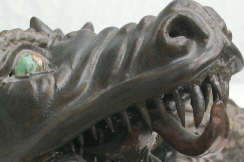In 2005 Clive Tucker was invited to exhibit in the Burlington Art Centre (BAC) in Burlington, Ontario. It was a site specific show for the courtyard gallery called Sipping Only What Is Sweet.
The work explored that which we see everyday, and that which we don’t want to see, specifically how we view the environment around us and what is actually taking place within those surroundings.
The origin of the show is Clive’s interest in questioning humanity's tendency to solve environmental problems with technology. To present his point, Clive used the bee. The bee plays a large role in human existence by pollinating our crops. It is reported that one in three mouthfuls of the food we eat is the result of pollination. But bee populations are at risk.
Clive populated the BAC courtyard gallery with 30 ceramic pollinators split into three unique groups of sculptures. The first set was comprised of native pollinators, all different and representative of the natural biodiversity of the planet. The second set was comprised of identical European honeybees. This species has been promoted largely at the expense of native bees, and major changes in agriculture policy have been made to the environment with virtually no regard for native bees. Yet, even this species is in decline. The third set of sculptures is of robotic pollinators, an artistic interpretation of a possible future.
The installation was set up so that swarms of robotic bees chased the European honeybees which were in turn chasing the native pollinators. The question brought to bear was: what will pollinate our crops? More importantly, are we continually creating and solving problems with technology, or can we actually move forward as a species in a more holistic direction?
Bees are instantly recognizable and suggest a simplicity that is deceiving. Yet, so large were these bees that viewers could not swat them away but were forced to consider their role in our surroundings.
|



